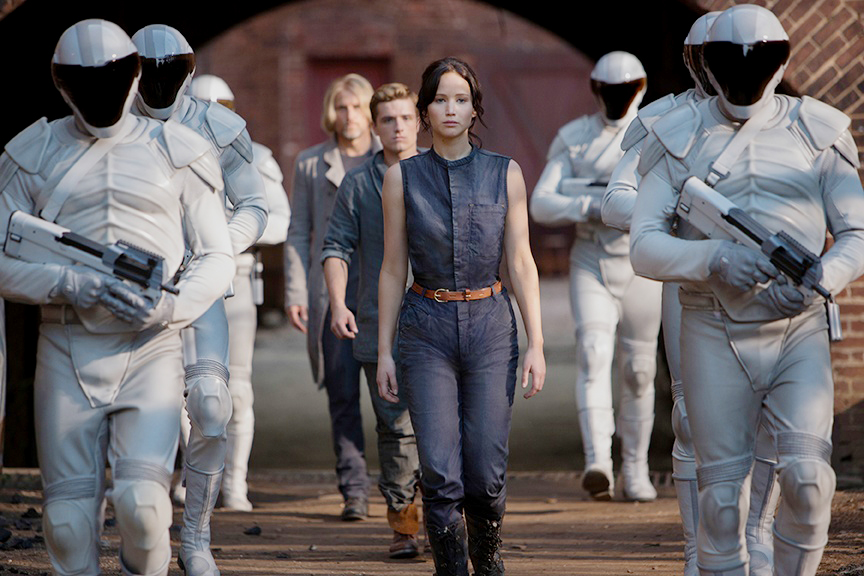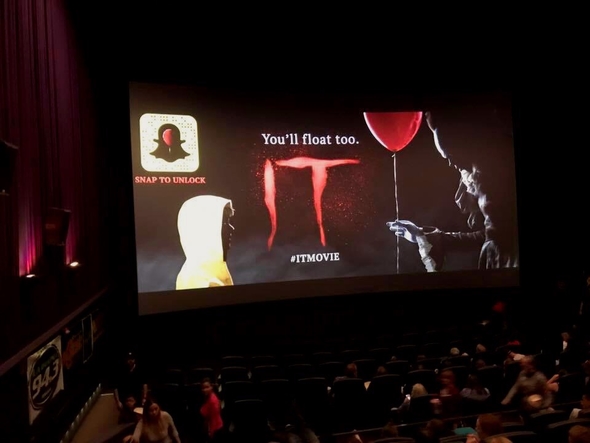“Exposure can kill as easily as a knife,” cautions the woman who introduces Katniss Everdeen and her fellow tributes to their training sessions for the Hunger Games. She is advising them to practice survival skills as well as combat techniques. But the formulation resonates throughout the first film based on Suzanne Collins’ trilogy and into the second, The Hunger Games: Catching Fire, which has been a worldwide box-office smash since its premiere.
Rarely has a fictional narrative been so powerfully reinforced by its real-world frame. Star Jennifer Lawrence has suggested that she can play Katniss so effectively because her life has been turned upside down by her sudden rise to prominence, much as the life of the trilogy’s heroine is. The film’s promotional machinery eerily doubles the sort that showcases Katniss and her fellow victor — and putative love interest — Peeta Mellark as they tour the different districts that are asked to sacrifice their young people each year to the Games.
To be sure, Lawrence and co-star Josh Hutcherson are not literally asked to fight anyone to the death. But in an entertainment business that exploits underage talent with little care for its future well-being — Britney Spears, Lindsay Lohan, and Miley Cyrus come ineluctably to mind — and even makes a kind of sick game out of planned obsolescence, seeing the actors from the Hunger Games on dozens of magazine covers and assorted tie-in ads cannot help but invoke the specter of overexposure.
That is what makes the publicity-related scenes in the two films so powerful. As we witness the Reaping, in which the selection of tributes is packaged for a television audience; as we watch the tributes being preened and prepped for public consumption; as we listen to their interviews with the unctuous Caesar Flickerman, who unfailingly extracts human interest stories from their plight; and as we see the way Katniss and Peeta’s victory tour in Catching Fire is stage managed, even as the prospect of civil war shadows them at each stop, we are inevitably reminded of the way our own celebrities are created and sustained.
Yes, the Hunger Games franchise owes much of its success to canny marketing. But it also invites us to interrogate its commercial dimension — and that of the whole business — at a fundamental level. In this regard, the films have more in common with Hollywood classics like A Star is Born and A Face in the Crowd than your typical dystopian fare. They are forceful critiques of the culture industry, bringing new life to a concept that many media scholars had considered hopelessly out of date. Part of this has to do with the totalitarian political landscape that Collins depicts, in which there are presidents still, but no democratic process to select them. But we also get the impression that the Games have become a semi-autonomous spectacle, one which inhabitants of Panem’s most downtrodden districts follow intensely regardless of any antipathy towards the Capitol.
While it is logical to presume that there is other national television programming when the Hunger Games are not in session, they are clearly the highlight of the broadcast year. Analogies to the Olympics or World Cup are inadequate but help us understand, particularly in this age of fragmented audiences, that this is one event that almost everyone is watching. Early in the first film, Katniss’s hunting partner and would-be boyfriend Gale, stoutly rendered by Liam Hemsworth, explains how this plays out. Although about as distrustful of the Capitol as it is possible to be while still living under its aegis, he confesses that he, too, has been glued to the screen.
“You root for your favorites. You cry when they get killed. It’s sick.” But he can also imagine an alternative to this voyeuristic identification. “What if they did? Just one year, what if everyone just stopped watching? What if they did? What if we did?. . .If no one watches, then they don’t have a game. It’s as simple as that.” When Gale asks what would happen if people simply stopped watching the Games, he is clearing space for a position outside of the spectacle. It’s no accident, then, that he does so while he and Katniss are beyond District 12’s boundaries, in the forbidden wilderness area where the Capitol’s power seems to diminish. Although they have seen its hovercraft cruising overhead during their hunting trips there, they still regard it as a refuge where they are safe from the scrutiny that dominates the rest of their lives.
Yet this proves a naïve supposition. Collins’ story arc ultimately demonstrates that this area is more closely monitored by the Capitol than initially appears to be the case. Early in the new film, Donald Sutherland’s quietly menacing President Snow pays Katniss a visit prior to the start of her victory tour with Peeta. As she enters the room where he has been waiting for her — she has been hunting with Gale in the wilderness again — we see him preoccupied by a holographic projection. Snow makes it clear that he knows where she has been and with whom, then lets her catch a glimpse of Gale kissing another girl.
Is this a feed from one of the surveillance cameras that monitor the inhabitants of District 12? Or could it rather be a fiction, cooked up by the Capitol’s technologists to deceive Katniss? Either way, this clip reinforces the sense that President Snow knows all of her secrets. Although many people in her community are aware that she and Gale cross the fence into the wilderness to supplement their meager food rations, the fact that she has romantic feelings for him has been kept tightly under wraps. Indeed, this love interest represents her point of maximum vulnerability, since her survival in the previous year’s Games was powerfully aided by the audience’s belief that she and Peeta were star-crossed lovers.
This unsettling scene encourages us to ascribe new significance to a sequence from the first film. Shortly after Katniss and Peeta arrive in the Capitol, we see her being ushered into the penthouse suite where she will sleep during her preparation for the Games. The space is ludicrously luxurious by the standards of District 12, a showcase for modern design completely at odds with her hardscrabble Dorothea Lange-esque origins. But Katniss seems curiously unfazed by her surroundings, heading straight for the bed, where she picks up a remote control.
Intuitively grasping its purpose, she uses it to change the view out of the suite’s floor-to-ceiling windows. Her first selection is a street-level feed from somewhere in the Capitol, showing its fashion-forward residents as they walk by. Because the image is shot in daylight, however, it is clearly a recording rather than an example of real-time surveillance. Katniss quickly changes the channel to reveal a peaceful desert landscape with a few Joshua trees, seemingly devoid of any human presence. Then she changes it again to reveal a lush forest in sloping terrain, flush with birdsong, that clearly reminds her of the wild lands adjoining District 12 where she and Gale hunt.
Katniss is stopped short. With a series of subtle facial movements, Jennifer Lawrence manages to convey her character’s longing to return to the simpler life she led prior to volunteering as a tribute; her desire to rest with this peaceful landscape comforting her; and her reluctance to indulge this nostalgic urge. Soon she switches back to the real-time view of the city pulsing beneath her penthouse suite, as if to declare her resolve to stay grounded in the present. Although this is an effective scene the first time around, it is far more powerful in retrospect, from the vantage point of Catching Fire. For only then do we recognize the full implications of the channels at her disposal.
We already know from a scene in the first film, with a voiceover by Flickerman and his co-host, that the inhabitants of Panem revisit their favorite moments from past Games as a way to stimulate interest in the next go-round. And those who have read Collins’ books are also aware that Katniss and Peeta begin their preparations for the ordeal by reviewing footage from previous years, searching for insight that might help them to survive in the arena. Although the focus of the nation is resolutely on what is happening live during each year’s Games, they also add to a historical record that powerfully reinforces the ritual’s cultural significance. When people aren’t living vicariously through the participants’ struggle to survive, they are frequently reliving the experience, even in places like District 12 where one’s day-to-day existence is by no means secure.
Katniss, in other words, is perfectly familiar with letting the camera transport her to places and times radically different from her own immediate surroundings. The remote control in her bedroom does not surprise or perplex her because she is already firmly established as a subject of the culture industry. If she insists on keeping her feelings to herself, it is not because she is some media primitive who fails to understand how Panem’s reality television works, but because she understands it all too well.
When President Snow confronts Katniss at the beginning of Catching Fire, the cloud that passes over her face take us back to that penthouse suite, as if she were now finally able to make sense of the unease that view of the woods inspired. It isn’t just the arena that was under the Capitol’s constant surveillance, but potentially every place she has ever been. The Hunger Games, she suddenly realizes, don’t simply serve to remind Panem’s districts of the price to be paid for rebelling against the Capitol, but also acculturate their audience to a society in which privacy is no longer possible. The myriad hidden cameras that provide access to the most intimate scenes in the Games, such as her kissing the gravely wounded Peeta in a “hidden” cave, can be located anywhere: in the streets back home, in her house, even in the most seemingly inaccessible parts of the wild lands on the other side of the district boundary. After all, one of them had to have recorded the feed she was briefly tempted by in the suite.
This attentiveness to retroactive forms of insight, the way we revisit the past in light of the present, may be the most impressive thing about Collins’ Hunger Games trilogy and the two cinematic adaptations that have been completed so far. It gives these troubling texts a depth that most other teen-oriented culture lacks, transforming them into a rich Bildungsroman in which we are politically educated alongside its protagonist. Although set in a future outwardly very different from the present, simultaneously more advanced and more backward, it tells the truth of our own threatening times, in which the overexposure of celebrities both masks and mirrors the disappearance of private life.
It’s no accident that the remote control scene in the first film is immediately followed by the commencement of the tributes’ first training session, nor that we soon see Peeta applying the artful camouflage to his skin that will ultimately save his life. When every possible refuge is potentially under surveillance, the only secrets worth keeping are those that can survive the light of day. Exposure can kill as easily as a knife, but you are more likely to survive if you acknowledge that you are always already exposed.
Film stills courtesy of Francis Lawrence.





